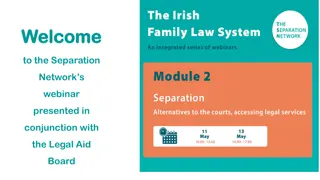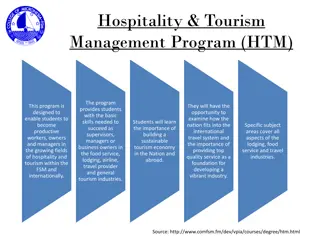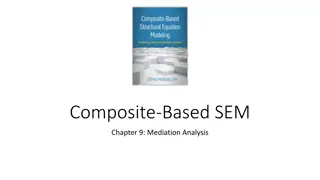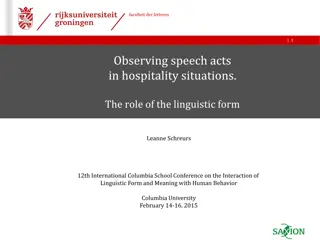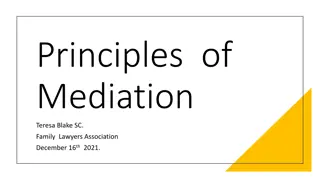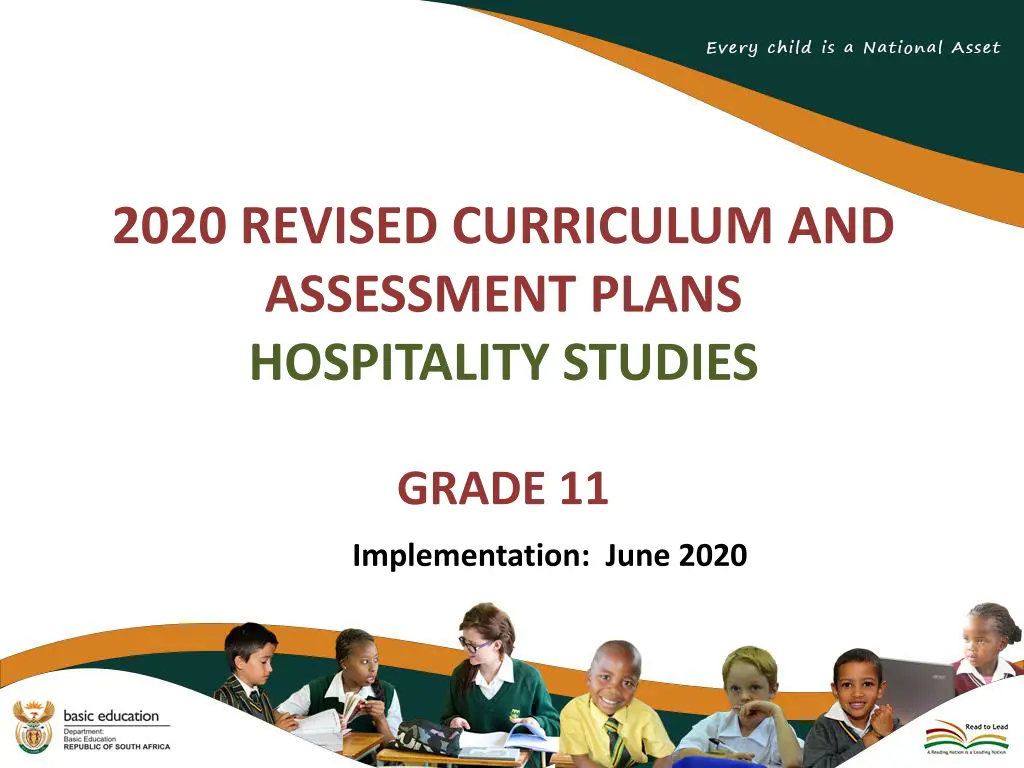
Hospitality Studies Grade 11 Curriculum and Assessment Plans 2020 Revision
Explore the amendments made to the Hospitality Studies Grade 11 curriculum for implementation in June 2020. Discover changes in content overview, annual teaching plans, and school-based assessments to ensure effective teaching, learning, and student preparation. Focus on essential core content, skills, and assessment methods for a comprehensive educational experience.
Download Presentation

Please find below an Image/Link to download the presentation.
The content on the website is provided AS IS for your information and personal use only. It may not be sold, licensed, or shared on other websites without obtaining consent from the author. If you encounter any issues during the download, it is possible that the publisher has removed the file from their server.
You are allowed to download the files provided on this website for personal or commercial use, subject to the condition that they are used lawfully. All files are the property of their respective owners.
The content on the website is provided AS IS for your information and personal use only. It may not be sold, licensed, or shared on other websites without obtaining consent from the author.
E N D
Presentation Transcript
2020 REVISED CURRICULUM AND ASSESSMENT PLANS HOSPITALITY STUDIES GRADE 11 Implementation: June 2020
Presentation Outline 1.Purpose 2.Amendments to the Content Overview for the Phase; 3.Amendments to the Annual Teaching Plan; 4.Amendments School Based Assessment (SBA) 5.Conclusion
1. Purpose To mediate the amendments of the trimmed and re-organised 2020 Annual Teaching Plan including School Based HospitalityStudies,Grade11 for implementation in June 2020 as stipulated in Circular S2 of 2020. To ensure that meaningful proceeds during the remaining teaching time as per the revised school calendar. To assist teachers with guided pacing and sequencing of curriculum assessment. Assessment for teaching content and
1. Purpose (continued) To enable teachers to cover the essential core content /skills in each grade within the available time. To assist teachers with planning for the different forms of assessment. To ensure learners are adequately prepared for the subsequent year/s in terms of content, skills, knowledge, attitudes and values
2. Amendments to the Content Overview for the Phase
Summary: Amendments to the Content Overview for the Phase Grade 10 Grade 11 Grade 12 *Trimmed * Reorganised *No amendment Sectors and Careers Sectors and Careers Sectors and Careers Food and beverage establishments Services provided by each Accommodation establishments Careers in accommodation establishments Kitchen brigade and restaurant brigade Policies governing working conditions. OHSA Learning pathways in the hospitality industry The contribution of the hospitality industry to the SA economy. Careers in the ancillary or support positions in hospitality establishments Opportunities for self- employment in the food and beverage sector. Marketing
Summary: Amendments to the Content Overview for the Phase Grade 10 Grade 11 Grade 12 *Trimmed * Reorganised *No amendment Nutrition and Menu Planning Significance of South African culinary uniqueness Providing food for different cultural needs Menu planning for hospitality establishments Menu planning for special tea occasions and three- course meals Costing a recipe and a portion of the recipe Nutrition and Menu Planning Nutrition and Menu Planning Menu planning: formal four-course dinners, cocktail functions, finger lunches Costing and calculating the selling price of a meal Drawing up quotations SA Food Pyramid Nutrients and their functions Nutritional value of meals Principles of menu planning Menu planning for continental and English breakfasts, brunches and light meals
Summary: Amendments to the Content Overview for the Phase Grade 10 Grade 11 Grade 12 *Trimmed * Reorganised *No amendment Kitchen and Restaurant Operations Restaurant Operations Kitchen and Kitchen and Restaurant Operations Appliances, equipment and utensils in the kitchen and restaurant Recipes Mise-en-place in the kitchen Cooking methods Knife skills Receiving stock Storekeeping Computing in the hospitality industry The use of computers in kitchen and restaurant operations Professionalism in the hospitality industry
Summary: Amendments to the Content Overview for the Phase Grade 10 Grade 11 Grade 12 *Trimmed * Reorganised *No amendment Food Commodities Food Commodities Food Commodities Yeast products Cakes and biscuits Stocks Soups Sauces Fish Poultry Rice Vegetables Herbs and spices Cocktail food and finger lunches Vegetarian dishes Desserts Gelatin Pastry Choux pastry Meat Preserved food Fruit Scones and muffins Pancakes, waffles and crumpets Tea and coffee Eggs Dairy products Cereals Minced meat and sausages Pasta, classic pasta sauces Salads and salad dressings Interpretation of recipes
Summary: Amendments to the Content Overview for the Phase Grade 10 Grade 11 Grade 12 *Trimmed * Reorganised *No amendment Food and Beverage Service Mise-en-place in restaurant Continental and English breakfasts, brunches and light meals Table setting Service and clearing techniques for buffet-style and plated service Customer relations Food and Beverage Service Types of service Preparing venue and setting tables for teas and three-course meals Sequence and techniques of food and beverage service for table d h te menus. Greeting and serving guests Food and Beverage Service Storage Regulations for selling wine with meals on premises. Serving of non-alcoholic beverages Serving of formal four- course dinners, cocktail functions or finger lunches Handling guests complaints
Summary: Amendments to the Content Overview for the Phase Grade 10 Grade 11 Grade 12 *Trimmed * Reorganised *No amendment Hygiene Hygiene Hygiene Food poisoning, food spoilage, food contamination, temperature control Preventative safety measures Handling emergency situations Food-borne diseases Personal hygiene Hygiene on food premises General safety practices in the kitchen and restaurant Basic treatment of injuries Kitchen pests
3. Amendments to the Annual Teaching Plan
Summary: Reorganisation/trimming of content topics Topics reorganised Food and Beverage Service Food Commodities Hygiene Safety and Security Kitchen and Restaurant operations Sectors and Careers Topics trimmed Nutrition and Menu planning Food Commodities Hygiene Kitchen and Restaurant operations Sectors and Careers
Summary: Amendment to the weighting of content topics Weighting of content topics in the November paper was aligned to the amendments that were implemented.
Gr 11 Summary: Content/Topics Amended Content/Topics Term Amendment=Reorganisation Term 2 Week 1 Food and Beverage Service Types of service Reorganised Types of service (Term 2 Week 2) moved to Term 2 Week 1 Reorganised Service (Term 2 Week 3) moved to Term 2 Week 2 Reorganised Stock (Term 2 Week 6-7) and Herbs & Spices (Term 2 Week 1) moved to Term 2 Week 5 Reorganised: Herbs, spices, condiments and flavourants (Term 2 Week 1) moved to Term 2 Week 5 Term 2 Week 1 Food and Beverage Service Service Term 2 Week 5 Food commodities Stocks Term 2 Week 5 Food Commodities Herbs, spices, condiments and flavourants
Gr 11 Summary: Content/Topics Amended Content/Topics Term Hygiene Temperature control in the kitchen Amendment=Reorganisation Temperature control in the kitchen (Term3 Week 9) moved to Term 4 Week 1 Term 4 Week 1 Reorganised preventive safety measures (Term2 Week 10) moved to Term 4 Week 2 Safety and Security Preventive safety measures Term 4 Week 2 Term 4 Week 2 Reorganised receiving stock (Term 4 Week 1 ) to Term 4 Week 3 Kitchen and Restaurant Operations Receiving stock Term 4 Week 4 Kitchen and Restaurant Operations Storekeeping Reorganised storekeeping (Term4 Week 2) moved to Term 4 Week 4 Term 4 Week 5 Sectors And Careers Policies governing working conditions in the hospitality industry Reorganised policies governing working conditions in the hospitality industry (Term 4 Week 3) moved to Term 4 Week 5.
Gr 11 Summary: Content/Topics Amended Content/Topics` Sectors and Careers Occupational health and Safety Act (OHSA): Term Term 4 Week 6 Amendment=Reorganisation Reorganised Occupational Health and Safety Act (OHSA) (Term 4 Week 4) moved to Term 4 Week 6 Reorganised: Learning Pathways in the Hospitality Industry (Term 4 Week 5 ) moved to Term 4 Week 6 Term 4 Week 2 Sectors and Careers Learning pathways in the hospitality industry
Gr 11 Summary: Content/Topics Amended Content/Topics Food Commodities: Fish Amendment = Trimming Refer to the food pyramid for nutritional value. Classification according to origin: saltwater fresh water Classification according to flesh: white and oily Classification according to shape: round or flat Shell fish: molluscs and crustaceans Cephalopods: octopus, squid Refer to the food pyramid for nutritional value. Types: chicken, duck, turkey Term Term 2 Week 3 Food Commodities: Poultry Term 2 Week 4 Food Commodities Herbs, spices, condiments and flavourants Term 3 Week 2 Remove: Origin, description
Gr 11 Summary: Content/Topics Amended Content/Topics Nutrition and menu planning Culinary cultural heritage of SA Amendment = Trimming Remove influences from Cape Malay, Indian and African Term Term 3 Week 1 Food Commodities: Soups Refer to the food pyramid for nutritional value. Convenience soups Refer to the food pyramid for nutritional value. Refer to the food pyramid for nutritional value. Classification and types: Long grain such as basmati. Short grain such as Arborio. Brown rice. Speciality rice Different workstations and kitchen layout in commercial kitchens, considering functions, workflow and prevention of cross-contamination Term 3 Week 4 Food Commodities: Vegetables Term 3 Week 5 Term 3 Week 6 Food Commodities: Rice Hygiene Food contamination Term 3 Week 8
Gr 11 Summary: Content/Topics Amended Content/Topics Kitchen and Restaurant Operations Storekeeping Term Term 4 Week 4 Amendment = Trimming Requirements for a food store: cleanliness and safety, storage temperatures, store containers Different types of food stores: dry foods stores, fruit and vegetable stores, refrigerated stores, freezers, chill cabinets (refrigerated display units), hot holding (foods that are already hot, not re-heating) Sectors and Careers Learning pathways in the hospitality industry Term 4 Week 7 Universities and Universities of Technology (higher education) Unit standard-based learning programmes through the Tourism, Hospitality and Sport Sector Education Authority (THETA) Further Education and Training (FET) colleges Registered private institutions
4. Amendments School Based Assessment (SBA)
Summary: Revised Programme of Assessment Term 1 Term 2 Term 3 Term 4 Task 1: March Test 75 % Task 4 SBA September Test 75 % Term 1+2+3 = 225 ( 2.25) to convert to 100 Task 2: Task 3 Task 5 Three (3) Practical Lessons and a Skills Test 25% Three (3) Practical Lessons 25% Three (3) Practical Lessons 25% PAT (ONE) Task 100 November Examination 200 400 4 100 100 25 100
Summary: Gr 11 November Examination Structure Section Content Mark allocation Short Questions (all topics) A 30 Kitchen and Restaurant operations Hygiene, Safety and Security B 20 Nutrition and Menu Planning Food Commodities C 60 2x30 Sectors and Careers Food and Beverage Service D 40 2x20 Convert to 200 marks 150
Summary: Revised Practical Assessment Task (PAT) The original PAT consists of: PAT 1 100 marks The format is amended to accommodate social distancing and acceleration of time. Weighting of marks not affected. SKAV assessed are standardised. No restaurant function Chefs: Individual preparation of TWO dishes. The prepared dishes are plated. Waitrons: Food and Beverage Service: Written assessment.
Conclusion SBA A uniform, standardised approach is used across Grade 10-12 in Hospitality Studies. No important aspect of the Grade 12 curriculum is compromised. Re-organisation, maintains and supports the foundational principles of the National Curriculum Statement (NCS) as stated for Tourism. The allocated time on the revised ATP is realistic to teach content/ activities and assessment and are aligned to the available time. The ATP exposes learners to a variety of forms of assessment. The amended School Based Assessment (SBA) aligns to the content and time available. Informal assessment focuses on the principles of assessment for learning in the context of specific or a combinations of topics. Informal activities prepare the learner for the formal assessment and final NSC examinations. PAT The amendment for the Gr 12 PAT aligns to the time available. Social distancing requirements are adhered to.
Contact Details Name: Magda van Pletzen CES: Services Subjects Department of Basic Education Tel: 0828264217 Email: vanpletzen.M@dbe.gov.za






